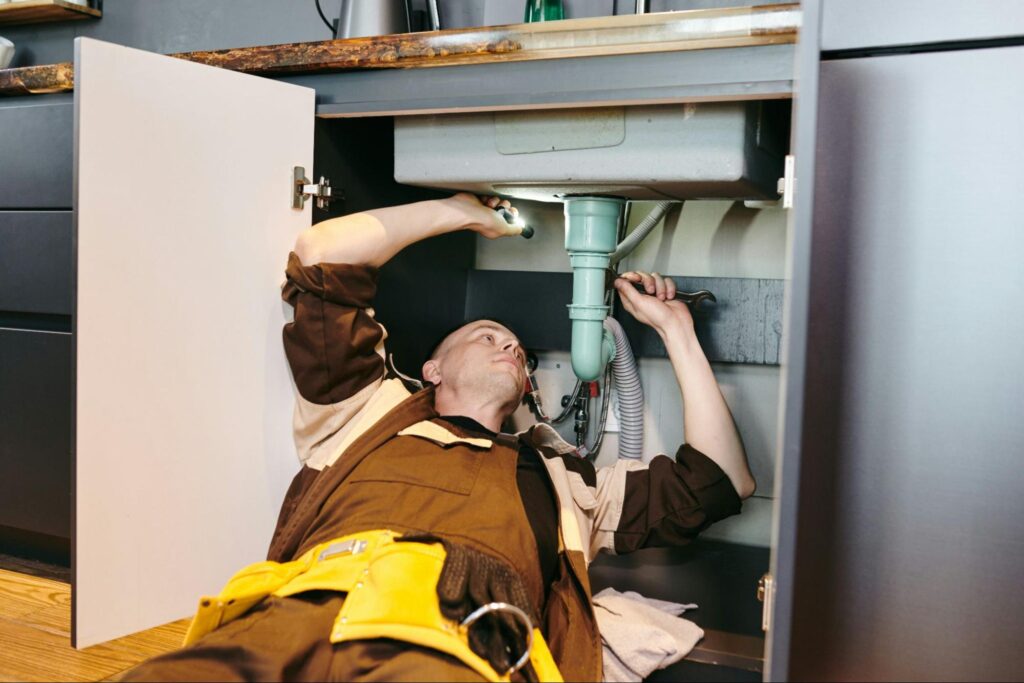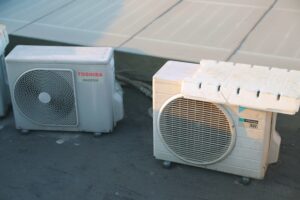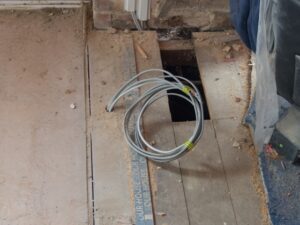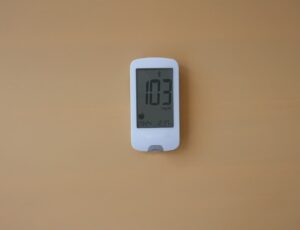If you’ve ever been greeted by a foul odor wafting up from your drain, you know just how unpleasant it can be.
A smelly drain is not only an inconvenience but can also be a sign of an underlying issue. Whether it’s a mild scent or something more potent, getting to the root of the problem can save you both time and money.
So, what’s causing the smell in your drain, and how can you fix it?
Let’s explore some simple yet effective solutions that do the trick. If these DIY methods don’t quite work, don’t worry. Sometimes, the problem lies deeper within the pipes, and that’s where professional plumbing services come into play.
At Excel Mechanical, we don’t just tackle plumbing problems; we solve them for good. Our experts specialize in making your drains smell fresh again and ensuring your plumbing system runs smoothly.
In this blog, we will cover:
- Simple DIY Solutions – Quick methods like using baking soda and vinegar to neutralize odors.
- Common Causes of Drain Odors – Understanding what might be causing the smells in the first place.
- When to Call a Professional – Knowing when it’s time to get expert help for stubborn drain problems.
Ready to find out how to eliminate those stinky drain problems?
Let’s dive in!
Identifying the Cause of Drain Odor
Understanding why a drain smells can help you address the issue effectively. Odors usually come from common sources, and knowing what to look for can simplify the inspection process.
Materials Needed for Inspection
Before you begin, gather some basic materials.
You will need a flashlight to see into dark areas and a pair of rubber gloves to protect your hands. A small mirror helps view hard-to-see spaces. Lastly, a wrench could be necessary to disassemble any parts for a deeper inspection.
This straightforward approach ensures you have everything required to identify problems without making multiple trips to the store. These simple tools make the inspection process easier, allowing you to pinpoint any issues with minimal effort.
Common Sources of Drain Odors
Several things can cause drains to smell.
- A common cause is the buildup of food particles in kitchen sink pipes, especially if these pieces rot over time.
- In bathrooms, hair, and soap scum are frequent culprits.
- Trapped debris can produce strong and persistent smells.
- Another reason could be a dry P-trap, which normally holds water to block sewer gases. When this trap dries up, unpleasant odors can enter your space.
- Mold or mildew around drain areas can also contribute to the smell.
In such situations, it’s wise to seek professional help.
Basic Cleaning Techniques
A few simple cleaning methods can help solve a smelly drain. Common household items like boiling water, baking soda, vinegar, or an enzymatic cleaner can effectively tackle odors.
Boiling Water Flush
To start, boiling water is a quick and easy way to clean a smelly drain.
- First, boil a large pot of water.
- Carefully pour the boiling water down the affected drain in a steady stream. This method helps by flushing away any small debris or soap scum that might be causing the odor.
- The heat can break down greasy residues that trap odors.
For the best results, you should repeat this process a few times. This approach is most effective for mild clogs or buildup inside the pipes. It is a simple and chemical-free option that relies on the temperature of the water to clean.
However, it’s not recommended for PVC pipes, as the high temperature might damage them.
Baking Soda and Vinegar Treatment
Another effective method involves baking soda and vinegar.
- Start by pouring about half a cup of baking soda into the drain.
- Next, add a similar amount of vinegar. The mixture will bubble and fizz, helping to break down any gunk inside the drain.
- Allow the mixture to work for about 15 to 20 minutes.
- Once the fizzing stops, flush the drain with boiling water to remove the loosened debris.
This natural method is excellent for removing odors and can be done as regularly as needed. It’s a chemical-free option that’s safe for most types of plumbing and can effectively handle mild to moderate buildup.
Enzymatic Cleaner Application
Enzymatic cleaners are another option for tackling stubborn drain smells. These cleaners contain natural enzymes and bacteria that digest organic matter, causing the odor.
Pour the enzymatic cleaner down the drain as directed in the product’s instructions. Allow it to sit for the suggested time to break down the material effectively.
This type of cleaner is safe for regular use and environmentally friendly. It excels at maintaining clean drains without harsh chemicals, providing an excellent solution for residential and commercial needs.
Deep Cleaning the Drain
Cleaning the pipes deeply can fix a smelly drain. Key steps include disassembling the P-trap, using a snake to clear blockages, and using hydro-jetting for thorough cleaning.
Disassembling the P-Trap
Start by placing a bucket under the sink to catch water or debris.
- Using a wrench or your hands, loosen the slip nuts on both ends of the P-trap.
- Carefully remove the P-trap and empty its contents into the bucket.
- Clean the trap’s inside with a brush and soapy water to remove any residue.
- Rinse thoroughly to ensure no grime remains.
- Reassemble by fitting the P-trap back and tightening the nuts securely.
This procedure helps remove the gunk that causes bad odors.
Snaking the Drain
Using a drain snake can clear clogs further down the pipe.
- Insert the snake into the drain and crank the handle slowly, pushing the snake deeper.
- If you feel resistance, it means you’ve hit the blockage.
- Turn and push the snake gently to break up the blockage.
- Carefully retract the snake, taking care not to damage the pipe.
- Run warm water through the drain to flush away the remaining debris.
This can effectively remove stubborn clogs that trap alone can’t reach.
Hydro-Jetting
Hydro-jetting uses high-pressure water to clean pipes thoroughly.
It’s beneficial for tough and deep-seated blockages. The process involves spraying water at high pressure through the pipes and removing grease, soap build-up, and grime. It’s a powerful and efficient way to clean and maintain clear drains.
Hiring professionals is recommended for this task as it requires specialized equipment. Our team provides exceptional quality and value, ensuring your plumbing system works efficiently for your home or business.
This method can provide a long-lasting solution to your smelly drain issues, keeping your plumbing clear.
Preventative Maintenance
Keeping drains smelling fresh involves regular upkeep to avoid buildup and blockages. Focus on cleaning, proper waste disposal, and using drain screens to maintain cleanliness and prevent odors.
Regular Cleaning Schedule
Establishing a regular drain cleaning schedule can prevent unpleasant smells.
Once a month, use a mix of baking soda and vinegar to break down residues. Afterward, pour boiling water to flush out any remaining particles.
Consider using enzymatic drain cleaners that help dissolve organic material slowly without damaging pipes. These cleaners rely on natural enzymes and bacteria to break down waste, making them a safe and eco-friendly choice.
Regular inspections by professionals can also help identify minor issues before they become bigger problems. This proactive approach can save time and money.
Proper Disposal of Waste
Improper waste disposal can cause drains to smell bad.
Always dispose of grease, oil, and fat in the trash instead of pouring them down the sink. These substances can solidify and create clogs inside pipes.
Avoid flushing non-biodegradable items like wipes, cotton swabs, and dental floss, as these don’t break down easily. They can cause blockages, leading to trapped odor-causing particles. Compost food scraps instead of sending them down the drain, which keeps your plumbing clear.
Adopting proper disposal methods protects your plumbing and keeps drains smelling fresh.
Using Drain Screens
Drain screens prevent hair, food particles, and debris from entering pipes. They are simple and effective tools that can be placed over drains in sinks, bathtubs, and showers.
Choose screens with small holes to catch even the tiniest particles. Regularly clean these screens to maintain efficiency. This prevents the buildup of materials that lead to foul odors.
Installing drain screens is a simple, affordable solution. They capture debris before it causes problems. Adding this small step can further ensure that your home remains free of unpleasant smells.
Troubleshooting Persistent Problems
When your drain smells persistent, it might indicate deeper issues. Checking the vent stack and sewer line can help identify the root cause. This section will guide how to address these common problems.
Identifying Vent Stack Issues
Vent stacks allow air to enter the plumbing system and help maintain proper air pressure.
If your drain smells, the vent stack may be clogged. Leaves and debris can block the vent, leading to slow drainage and odors.
To inspect the vent stack, go up to the roof where the pipe extends. Make sure it is clear of obstructions. Use a flashlight to check for blockages. Pouring water down the stack can flush out minor debris. Ensure the screen at the top is intact, preventing future clogs from leaves or twigs.
Blocked vents can allow powerful sewer odors to enter your home. If this problem persists, you should hire a professional plumber.
Assessing Sewer Line Integrity
The sewer line might have issues if the problem is not with the vent stack.
Damaged or cracked sewer lines can cause recurring odors.
Changes in soil moisture or ground movement can lead to such damage.
Steps to assess the sewer line include observing signs such as frequent drain clogs, slow drains, and persistent odors. Tree roots invading the line are a common cause of sewer line failure. A professional camera inspection can confirm your sewer line’s condition.
If damage is found, repair or replacement might be necessary.
When to Call a Professional Plumber
If your drain smells keep coming back, you might need help. Sometimes, DIY methods are not enough to fix deeper problems.
- Strange noises or gurgling sounds can signal trouble. These noises often mean blockages or issues in the plumbing that need expert attention.
- Another sign is repeated clogs or backups. If these happen often, it’s time to call the pros.
- Water draining slowly or not at all is a serious problem. It can suggest big blockages or pipe damage.
- If you see leaks or water damage, act swiftly. If not addressed immediately, leaking pipes can cause expensive damage.
- Unpleasant odors coming from multiple drains could indicate sewer line issues. This is often a job for professionals to inspect and fix.
It could be a sign of a hidden leak if you notice wet spots or mold. A professional can find and repair these issues. Don’t hesitate to seek expert help when needed. Skilled plumbers have the tools and knowledge to fix problems efficiently.
Final Considerations and Best Practices
When dealing with a smelly drain, regular maintenance is key.
It’s essential to flush your drains with hot water at least once a week to help prevent odors from building up. This simple step can dislodge debris and soap scum that may cause unpleasant odors.
Consider using natural cleaners like baking soda and vinegar. They can effectively break down organic matter and deodorize your pipes.
Tips for Routine Maintenance:
- Weekly Flush: Use hot water to rinse out any residue.
- Monthly Clean: Combine baking soda and vinegar for an eco-friendly clean.
Do not overlook potential issues with plumbing traps. If they dry out, odors can escape. Make sure they stay filled with water, especially in rarely used drains.
If problems continue, contact a professional. Excel Mechanical can provide expert help with HVAC and plumbing needs. Our team is experienced in delivering exceptional quality.
Benefits of Choosing Excel Mechanical:
- Professional expertise in HVAC and plumbing solutions.
- Quality service tailored to individual needs and budgets.
Regular attention to your drainage system improves air quality and prolongs the lifespan of your plumbing. It’s always wise to address minor issues before they become major problems.
Frequently Asked Questions
Dealing with a smelly drain can be frustrating, but with the right steps, you can resolve the issue quickly. To make sure you’re fully equipped to handle any lingering questions, here are some answers to the most commonly asked questions about drain odors.
What natural remedies can eliminate odor from bathroom drains?
Baking soda and vinegar can help neutralize odors. Pour some baking soda down the drain, followed by vinegar. After it foams up, rinse with hot water. These ingredients work together to break down build-up and kill bacteria that cause smells.
Why does my bathroom drain emit a sewage-like smell?
A sewage-like smell often indicates a dried-out p-trap. The p-trap holds water to block sewer gases. If water evaporates, the gases leak into the bathroom. Running water down the drain can refill the trap and block gases.
What steps should I take to resolve odor issues in my kitchen sink drain?
First, clean the garbage disposal if your kitchen sink has one, as trapped food can cause smells. Next, flush the drain with boiling water, followed by a mix of baking soda and vinegar. Let it sit, and finish with another hot water rinse to clear the odor.
How can I prevent my shower drain from developing a foul smell?
Prevent smells by regularly removing hair and debris from the drain cover. Pouring hot water down the drain periodically helps dissolve soap scum and residue. Weekly use of natural drain cleaners can also keep odors at bay.
What causes a p-trap to start smelling, and how can it be fixed?
A p-trap may smell if it loses its water seal, preventing sewer gases from entering your home. Regularly running water through the drain, especially in rarely used fixtures, can prevent this. If clogged, cleaning or replacing the p-trap might be necessary.
Can vinegar be used to combat odors in household drains?
Yes, vinegar is effective in combating drain odors. It’s a natural cleaner and deodorizer. Pouring vinegar into the drain helps break down grime and removes bacteria. Follow with warm water to flush out the residue, maintaining a fresh-smelling drain.




